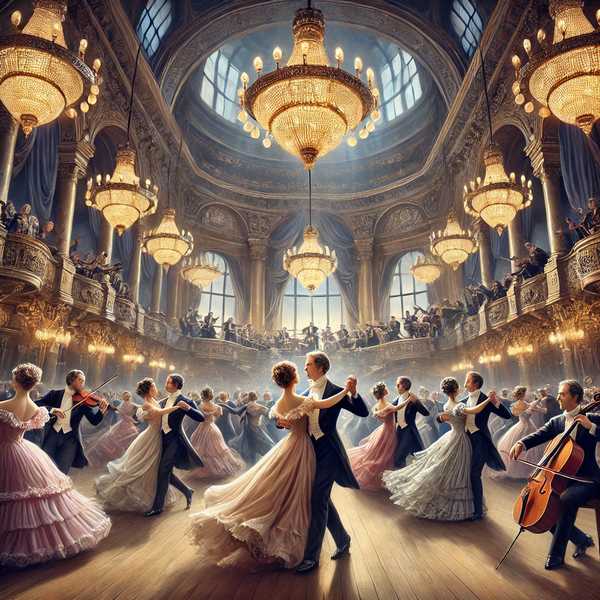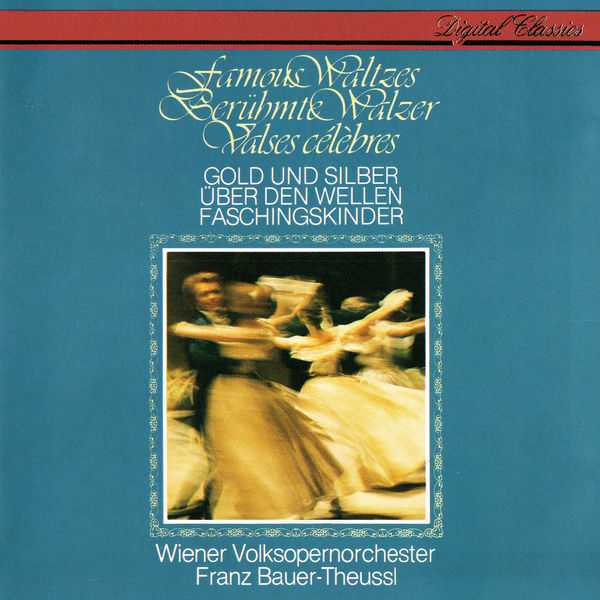Famous Waltzes

The waltz, with its elegant, flowing rhythm in triple time, has long been a symbol of refinement and romance, a staple of both social dances and concert music. Emerging in the late 18th century in Austria and southern Germany, the waltz evolved from folk dances like the *Ländler* and quickly became a sensation, sweeping through the ballrooms of Europe. As composers embraced this dance form, the waltz found its place not just in social gatherings but in symphonies, operas, and piano music, each iteration adding to its rich legacy.
The Origins of the Waltz
The waltz began as a folk dance in rural regions of Austria and Bavaria during the mid-to-late 18th century. These early waltzes were considered revolutionary due to the close embrace of the dancers, which was scandalous at the time. As it moved into urban settings, the waltz gained sophistication, entering the ballrooms of Vienna, where it evolved into a graceful, swirling dance that would define much of European high society. The waltz’s 3/4 time signature gives it a lilting quality, where the first beat is strong, followed by two lighter beats, creating the familiar “oom-pah-pah” rhythm.
Johann Strauss II – The Waltz King
No discussion of waltzes would be complete without mentioning Johann Strauss II, often referred to as the “Waltz King.” His name is synonymous with the golden age of the Viennese waltz in the 19th century. Strauss transformed the waltz from a simple dance tune into a sophisticated orchestral form, expanding its musical depth and emotional range.
One of Strauss’s most famous works is *”The Blue Danube”* (*An der schönen blauen Donau*), composed in 1867. Initially written as a choral work with lyrics by Josef Weyl, it was soon adapted into an orchestral version, which became a massive success. Its soaring melodies evoke the beauty and grandeur of the Danube River, and it quickly became a signature piece of Viennese culture. The work is still performed worldwide, most notably during the New Year’s Concert of the Vienna Philharmonic, and it has been used in various films, including Stanley Kubrick’s *2001: A Space Odyssey*.
Strauss’s other famous waltzes include *”Tales from the Vienna Woods”* (*G’schichten aus dem Wienerwald*), which incorporates zither melodies that add a touch of rustic charm, and *”Voices of Spring”* (*Frühlingsstimmen*), a lively waltz celebrating the arrival of spring. His *”Emperor Waltz”* (*Kaiser-Walzer*) is another notable work, composed to commemorate the Austro-German alliance of 1889. These waltzes, with their lush orchestration, graceful rhythms, and memorable melodies, remain central to classical music and Viennese tradition.
Frédéric Chopin – The Poet of the Piano
While Johann Strauss II brought the waltz to the orchestral stage, Frédéric Chopin, the Polish composer and virtuoso pianist, brought it into the intimate setting of the salon. Chopin’s waltzes are not meant for dancing but are instead poetic piano works that explore a wide range of emotions, from exuberance to melancholy.
Chopin composed over a dozen waltzes, with some of the most famous being his *”Waltz in D-flat major, Op. 64, No. 1,”* commonly known as the “Minute Waltz.” Despite its nickname, it is not meant to be played in just one minute; the title refers to its quick, lively tempo. The waltz’s playful and delicate melodies, combined with Chopin’s intricate pianistic flourishes, make it a favorite among performers and audiences alike.
Another well-loved Chopin waltz is his *”Waltz in C-sharp minor, Op. 64, No. 2,”* which contrasts lyrical, melancholic passages with more lively, spirited sections. Chopin’s waltzes, including the *”Grand Valse Brillante”* in E-flat major (Op. 18), are highly expressive, blending elegance with emotional depth. Though Chopin’s waltzes are not written for the ballroom, they capture the essence of the waltz’s charm and grace, imbuing it with a level of introspection that was new to the form.
Pyotr Ilyich Tchaikovsky – Waltzes in Ballet and Opera
Pyotr Ilyich Tchaikovsky, the great Russian composer, incorporated waltzes into his ballets and operas, elevating the dance form to new artistic heights. His balletic waltzes are especially famous, as they blend the graceful motion of the waltz with the drama of the stage, creating iconic moments in the world of ballet.
One of the most famous waltzes in Tchaikovsky’s work is the *”Waltz of the Flowers”* from *The Nutcracker*. This piece, with its sparkling orchestration and whimsical charm, captures the magic and wonder of Tchaikovsky’s fairy tale ballet. The sweeping, elegant melodies convey the grace and beauty of flowers dancing in the Land of Sweets, making it one of the most beloved sections of the ballet. It is often performed as a standalone concert piece, and its popularity has only grown since the ballet’s debut in 1892.
Another iconic Tchaikovsky waltz can be found in *Swan Lake*, specifically the *”Waltz in Act I,”* which reflects the romantic and tragic undertones of the ballet. In *Sleeping Beauty*, the *”Garland Waltz”* is another standout moment, celebrating the joy of Princess Aurora’s birth with regal grandeur.
Tchaikovsky also utilized the waltz in his operas, such as in *Eugene Onegin*, where the *”Waltz in Act II”* accompanies a grand ball. This piece is elegant and noble, reflecting the aristocratic setting of the opera and serving as the backdrop for crucial character interactions. Tchaikovsky’s waltzes are integral to the dramatic fabric of his works, heightening both the emotional and visual impact of the scenes they accompany.
Maurice Ravel – The Modern Waltz
In the 20th century, Maurice Ravel brought a new perspective to the waltz with his orchestral work *”La Valse”*. Composed between 1919 and 1920, *La Valse* is often seen as a tribute to the Viennese waltz tradition but also a deconstruction of it. The piece begins with a hazy, swirling introduction, gradually coalescing into a recognizable waltz rhythm, before spiraling into a dizzying, almost chaotic conclusion. While some interpret *La Valse* as a reflection of the collapse of European society after World War I, others see it as a more abstract exploration of the waltz’s form and structure.
Ravel’s work is notable for its complexity and ambiguity, blending nostalgia for the past with a modernist sensibility. *La Valse* stands in stark contrast to the elegant, carefree waltzes of the 19th century, offering a darker, more introspective take on the dance.
Waltzes in Popular Culture
Beyond the concert hall, waltzes have also made their mark in film and popular culture. In addition to Strauss’s *”The Blue Danube”*, which gained iconic status through its use in Kubrick’s *2001: A Space Odyssey*, many waltzes have been featured in movies, television, and even video games, where they often evoke feelings of nostalgia, elegance, or grandeur.
In *The Godfather*, for example, Nino Rota’s waltz-like main theme helps set the tone for the film’s blend of family loyalty and tragedy. In Disney films, waltzes frequently accompany romantic or whimsical moments, such as in *Beauty and the Beast* and *Cinderella*.
As a Conclusion
The waltz has traversed centuries and genres, evolving from its folk roots into a sophisticated form that has been embraced by composers across the globe. From the orchestral grandeur of Johann Strauss II and the intimate piano works of Chopin to the balletic elegance of Tchaikovsky and the modernist interpretation of Ravel, the waltz remains a symbol of grace, romance, and beauty. Its enduring appeal, both as a dance and a musical form, continues to captivate audiences around the world, cementing its place in the canon of Western music.











